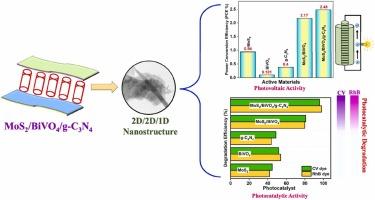g-C3N4与MoS2/BiVO4集成为2D/2D/1D异质结,增强了阳光下的光催化活性和DSSC性能
IF 7.1
2区 环境科学与生态学
Q1 BIOTECHNOLOGY & APPLIED MICROBIOLOGY
引用次数: 0
摘要
本文采用超声辅助水热法合成了MoS2/BiVO4/g-C3N4作为2D/2D/1D三元异质结,用于在阳光直射下光降解有机染料污染物,并作为染料敏化太阳能电池(DSSC)的对电极。二硫化钼/ BiVO4 / g-C3N4 nanohybrid被证实使用x射线衍射晶体结构的角度提出了14.45°,26.83°和28.44°,其官能团的红外光谱在598、474和804年 厘米⁻¹ ,其化学成分是XPS谱所示,包括密苏里州3 d、2 p, O 1 S C 1 S, Bi 4 f, V 2 p和N 1 年代,光学研究观察到UV-DRS光谱学在652年,579年和460年 nm,和它有一个缩小带隙1.83 eV,分别。进一步的SEM和HR-TEM研究表明,自组装的g-C3N4纳米棒和BiVO4纳米片被装饰在MoS2纳米片表面,形成2D/2D/1D纳米结构。在所有样品的结晶紫(CV)和罗丹明B (RhB)染料的光催化活性中,MoS2/BiVO4/g-C3N4杂化物的降解效率最高,分别为98 %和96 %。ESR、自由基俘获、Mott-Schottky测试和光致发光(PL)光谱的研究有力地证明了MoS2/BiVO4/g-C3N4杂化物的Z-scheme催化机理。基于MoS2/BiVO4/g-C3N4反电极制备的DSSC的Jsc、Voc、FF %和功率转换效率(PCE %)分别为5.54 mA cm−2、0.713 V、0.63 %和2.48 %,比原始MoS2制备的DSSC提高了2.6倍。MoS2、BiVO4和g-C3N4之间形成Z-scheme (N-P-N)异质结,改善了电荷分离,缩短了电荷转移距离,增强了界面相互作用,从而增强了光催化和光伏活性。该研究有望为合理设计和制造高效的Z-scheme MoS2/BiVO4/g-C3N4作为2D/2D/1D纳米杂化材料用于光催化废水处理和DSSC能量转换收集提供新的见解。本文章由计算机程序翻译,如有差异,请以英文原文为准。

g-C3N4 integrated with MoS2/BiVO4 as a 2D/2D/1D heterojunction for enhanced photocatalytic activity under sunlight and DSSC performances
In this work, MoS2/BiVO4/g-C3N4 as a 2D/2D/1D ternary heterojunction was synthesized by a sonication assisted hydrothermal method for photodegradation of organic dye pollutants under direct sunlight and serves as counter electrodes for dye-sensitized solar cells (DSSC). The MoS2/BiVO4/g-C3N4 nanohybrid was confirmed to have a crystal structure using X-ray diffraction angles presented at 14.45°, 26.83° and 28.44°, its functional groups were shown by FT-IR spectroscopy at 598, 474 and 804 cm⁻¹ , its chemical composition was shown by XPS spectroscopy, including Mo 3d, S 2p, O 1 s, C 1 s, Bi 4 f, V 2p and N 1 s, optical studies were observed by UV-DRS spectroscopy at 652, 579 and 460 nm, and it had a narrowing band gap at 1.83 eV, respectively. Further SEM and HR-TEM studies display that self-assembled g-C3N4 nanorods and BiVO4 nanoflakes were decorated on the MoS2 nanosheet surface, formed as 2D/2D/1D nanostructures. In photocatalytic activity of crystal violet (CV) and rhodamine B (RhB) dyes for all samples, the MoS2/BiVO4/g-C3N4 hybrid exhibited the highest degradation efficiencies of 98 % and 96 %, respectively. The investigations of ESR, radical trapping, Mott-Schottky test and photoluminescence (PL) spectra strongly provide evidence for the Z-scheme catalytic mechanism of the MoS2/BiVO4/g-C3N4 hybrid. The MoS2/BiVO4/g-C3N4 counter electrode based fabricated DSSC exhibits Jsc, Voc, FF % and power conversion efficiency (PCE %) of 5.54 mA cm−2, 0.713 V, 0.63 % and 2.48 %, respectively, which is 2.6 times higher than the as-prepared DSSC from pristine MoS2. The enhanced photocatalytic and photovoltaic activities were attributed to improved charge separation, shorter charge transfer distance, and stronger interfacial interaction by forming a Z-scheme (N-P-N) heterojunction between MoS2, BiVO4, and g-C3N4. This research is expected to provide new insights into the rational design and fabrication of highly effective Z-scheme MoS2/BiVO4/g-C3N4 as 2D/2D/1D nanohybrid for photocatalytic processes for wastewater treatment and DSSC energy conversion harvesting.
求助全文
通过发布文献求助,成功后即可免费获取论文全文。
去求助
来源期刊

Environmental Technology & Innovation
Environmental Science-General Environmental Science
CiteScore
14.00
自引率
4.20%
发文量
435
审稿时长
74 days
期刊介绍:
Environmental Technology & Innovation adopts a challenge-oriented approach to solutions by integrating natural sciences to promote a sustainable future. The journal aims to foster the creation and development of innovative products, technologies, and ideas that enhance the environment, with impacts across soil, air, water, and food in rural and urban areas.
As a platform for disseminating scientific evidence for environmental protection and sustainable development, the journal emphasizes fundamental science, methodologies, tools, techniques, and policy considerations. It emphasizes the importance of science and technology in environmental benefits, including smarter, cleaner technologies for environmental protection, more efficient resource processing methods, and the evidence supporting their effectiveness.
 求助内容:
求助内容: 应助结果提醒方式:
应助结果提醒方式:


